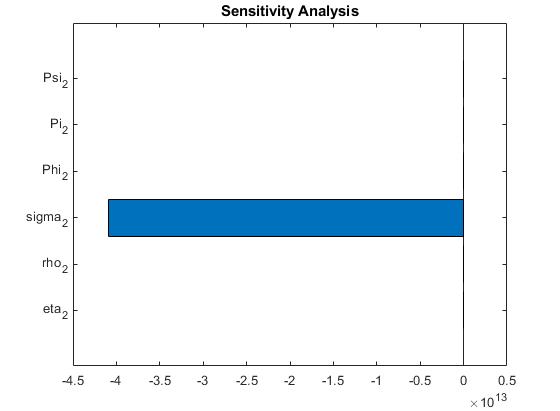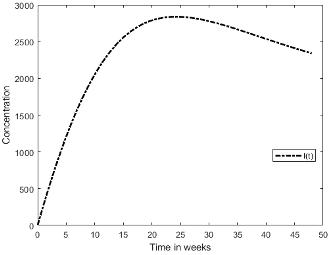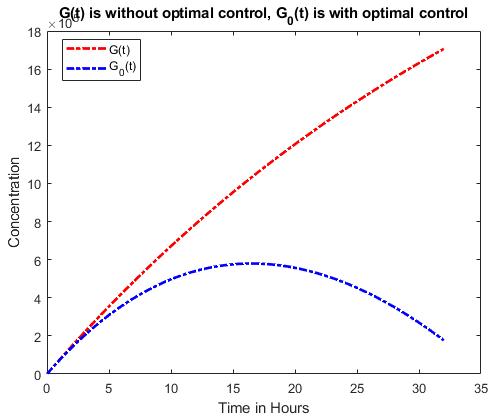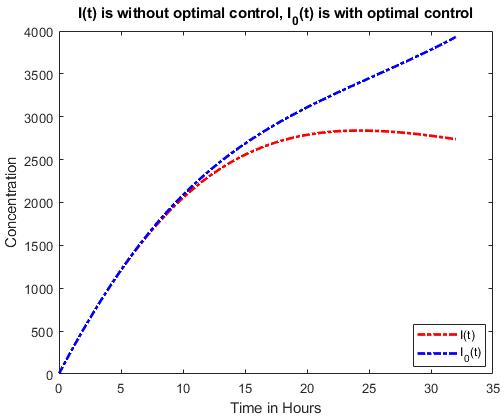A Model of Insulin-Glucose Concentration for Oral Ingestion of 75g of Glucose for Type-I Diabetes Management
Irene Melly Chebet1*, Rotich Titus2, Bitok Jacob11Department of Mathematics and Computer Science, University of Eldoret, Eldoret, Kenya 2Department of Mathematics, Physics & Computing, Moi University, Eldoret, Kenya
ABSTRACT
The regulation of glucose concentration in the body has triggered more often the stimulant approach. The hourly operation of insulinglucose-dependent bodily functions has left many type-I diabetic patients with a lot of pain. Doctors have proposed various measures such as oral ingestion of glucose to trigger insulin production to increase glucose uptake in the body. Such measures have not been mathematically modeled. In the current, a mathematical model formulating the concentration of glucose and insulin where extra glucose intake leads to extra stimulation of insulin production has beenpresented.Themathematicalrigorsuchasthewell-posednessof thesystemindicatedthattheproposedmodelisapplicableinreal-life applications. Numerical simulation indicates that both glucose and insulinconcentrationcontinuouslyincreases,asignofaneedtofind an optimal control strategy in order to manage type-I diabetes. A sensitivity analysis showed a constant rate of insulin-independent glucose disappearance is the most sensitive in the model. Optimal control investigation indicated that increasing the constant rate of insulin-independent glucose disappearance is effective after 15th hour. Future studies need to consider including other parameters, such as glucose accelerated loss due to exercise in the system.
KEYWORDS: Oral 75g glucose intake, Glucose concentration, Insulin Concentration, Insulin Stimulant
1. INTRODUCTION
Regularhumaninsulinproductioninthebodybegins to function after 30-60 min, and the peak concentration is witnessed after 2-4 hours [1]. The adverse effects are felt between 5 to 22 hours. However,thereisnoclarityonwhetherextraglucose usually taken by the patients effectively manages these effects.
Usually, 75g of glucose is taken orally to stimulate insulin production to regulate glucose concentration [2]. Absurdity often occurs when the patients take extra glucose but still experience the side effect of excessglucoseinthebody,whichoftenleadstotypeI diabetes.
Mathematically, the oral ingestion of glucose to stimulateinsulinproductionforglucoseuptakebythe body has not been studied. The biological interpretation of these phenomena has not been widely received with open understanding. Biologically, inter-organ dependence has dominated
How to cite this paper: Irene Melly Chebet | Rotich Titus | Bitok Jacob "A Model of Insulin-GlucoseConcentration for Oral Ingestion of 75g of Glucose for Type-I Diabetes Management" Published in International Journal of Trend in Scientific Research and Development (ijtsrd), ISSN: 2456-6470, Volume-6 | Issue-7, December 2022, pp.363-369, URL: www.ijtsrd.com/papers/ijtsrd52338.pdf
Copyright © 2022 by author (s) and International Journal of Trend in Scientific Research and Development Journal. This is an Open Access article distributed under the terms of the Creative Commons Attribution License (CC BY 4.0) (http://creativecommons.org/licenses/by/4.0)
the research area [3, 4], leaving a hole in the mathematical perspective.
Contribution
The proposed study has two major contributions 1. Theglucoseintaketostimulateinsulinproduction is evaluated to ascertain its effects on the overall glucose concentration in the body.
2. Establishing an optimal control of the system to regulate the glucose concentration in the body in the presence of extra glucose and insulin production.
Therestofthepaper isorganized asfollows:Section 2 presents the model formulated and governing equations.Section3thewellposednessofthesystem, investigating the system application in real life. Section4presentstheequilibriumofthesystem,such asdisease-freeequilibriumandendemicequilibrium, andbasicreproductivenumber.Section5presentsthe
estimation of parameter values, sensitivity analysis, and numerical simulation of glucose concentration and insulin in the body. Section 6 presents a formulation of the optimal control of the system. Section 7 presents the conclusion of the study.
2. Proposed Study
2.1. The model formulation
The model presented in Figure 1 shows the interaction between glucose and insulin concentrationinthebody.Glucoseisincreasedinthe body at a constant rate due to body metabolism such as food conversion. It is also increased in the body at a constant rate due to of glucose intake. It is depleted at a constant rate . Insulin concentration in the body is increased due to oral ingestionof glucoseof atrates .Theinsulinis decrease at rate and due to a constant rate insulin degradation and a constant rate insulin-dependent glucose disappearance .
Theorem 3.1 Suppose isgivenby(6),withits initial condition , is non-negative. System (1)-(2) solution is unique, non-negative, and bounded.
Proof. if are continuous functions and : exists then is locally Lipschitz continuous. .Therefore,atleastone compartmentisnon-empty.Thismeansthataunique solution of the system exists, defined in some time interval containing [5]. If we let be the smallest such that or . We use continuity of , and , such that if , then from (1) to show that , . This means that is an increasing function on interval , which in turn means that . We use the same approach to show that, if , then from (1) we get that . Thus, the solution to the system is non-negative. We usethedissipativityconditionoftheorem2.3.6in[6] to show that the solution of the system (1)-(2) exist globally as follows;
(7)
Therefore, a unique solution . Hence the solution is bounded.
Figure 1: A model formulating the interaction between glucose and insulin.
2.2. The governing equations (1) (2) with .
3. Well-posedness
3.1.
Existence of the solution
We show that the model (1) - (2) solution is unique, non-negative, and bounded, making it applicable in real life. Let and such that , where (3) (4) (5) So that equations (1) - (2) can be written as (6)
4.
Stability Analysis
4.1. Endemic Equilibrium
The equilibrium state is defined as when there is no changeinthesystem, .Endemicequilibriumis when , but no state variable is zero, that is, and . We derive the endemic equilibrium as follows;
We use (1) to get;
(8) We also use (2) to get;
(9)
We use (8) and (9) to get.
(10)
4.2.
Disease Free Equilibrium
The disease-free equilibrium, but and .We follow algebraic manipulations to show that , Hint we assume the
4.3.
The Basic Reproduction Number
We follow the works of [5, 6] to compute as follows:
(11)
We compute the jacobian matrix to attain (12) We attain F at the DFE as; (13)
4.6. Global stability analysis of the DFE Theorem 4.2 Suppose , the DFE of system (1) and(2) is globally asymptotically stable in andIf ,the DFE is unstable.
Proof. Weuseamatrix-theoreticmethodassuggested by [7]. We assume and . We consider , , and as defined in Section ??; then and dynamics of infected compartments is given by
thus, we can obtain as follows (17) while
We compute the inverse of as (14) We use (13) and (14) to compute as follows; (15)
We compute the eigenvalue to get as; (16)
is the constant rate of decrease of glucose concentrationduetoinsulin-dependentconstantrate, is the constant rate of insulin degradation; thus, istherateofdegradationofinsulin-andglucose in the body. is the glucose intake in the body, and is the constant glucose disappearance. is the oral ingestion of glucose, and is insulin increased duetooralingestionof75gofglucose.Therefore, is the sum of the constant rate of glucose and insulin reduction in the body.
4.4. Stability of DFE
4.5. Local stability analysis of the DFE
Theorem 4.1 Suppose is a DFE for the system (1) and (2), then is locally asymptoticallystableif andunstableif where is defined by Proof. See proof of Theorem 4.1 in [7].
We see that , , , in . It is also clear that is reducible. We can therefore construct a Lyapunov function based on Theorem and as statedby[8].Wedenotethelefteigenvectorsof corresponding to the eigenvalue of by . Then or (18) and (19)
We use equations (18) and (19) to derive a possible solution of . To allow work-ability, let . Thus, by Theorem of [8], we have astheLyapunovfunctionofthemodelis given by; We differentiate at DFE to get
International Journal of Trend in Scientific
and Development @ www.ijtsrd.com eISSN: 2456-6470
This implies that and or . Therefore, is the only invariant set in where . Thus, byLaSalle’s invariance principle [9], the , isglobally asymptotically stable in and
5. Numerical SImulation
5.1. Parameter Estimation
Table 1 gives a description and approximate values of the parameters.
Table 1:
Parameters description and values
Parameter Description Values Range Source
Insulin increased into the body due 75g glucose intake 275 250-300 [10] Glucose increase into the body due 75g glucose intake 75000 - [10] Glucose infused into the body 1.56 1.4-1.7 [11] Constant rate insulin-dependent glucose disappearance [11] Constant rate insulin degradation 0.0437 0.01-0.1 [11] Constant rate insulin-independent glucose disappearance 0.0226 0.01-0.09 [11]
5.2. Sensitivity analysis of the parameters

We perform sensitivity analysis to determine the most influential parameters on given by (16). This will informthedecisionontheparameterthatinfluencestheconcentrationof and .Sensitivityanalysisisusefulin showingthe closeness and relatedness of the parameters. A smaller change in parameter mayresult in a bigger change in . Figure 2 summarizes sensitivity analysis for the model parameters to .
Figure 2: Sensitivity analysis showing is the most sensitive. Thus, the constant rate of insulinindependent glucose disappearance is the most influential in the .
5.3. Numerical Simulations of the model system
The numerical simulation shows the curves of the concentration of glucose and insulin. Figure 5.3 shows the glucose and insulin concentration curves. The curves indicate that insulin concentration increases faster than glucose concentration.
Glucose Concentration
Ifwelet betheconstantrateofincreaseof ,then a set of admissible control is
(20)
6.1.
The Extended Mathematical Control
To effectively reduce the glucose concentration, increases the overall constant rate of insulinindependentglucosedisappearance,thustheextended model can be written as follows:
(21) with initial . A successful control minimizes glucose concentration. Thus, the control is considered optimal if it minimizes the objective function defined as (22) where are the unit cost of increasing the insulin in the body per unit of time.
6.2. Minimization of the objective function
We employ Pontryagin’s maximum principle and optimality conditions to obtain the solution to the optimal control problem (23) subject to (24).
Insulin Concentration
Figure 3: A plot of glucose and insulin concentration for a span of 48 hours.

Figure 3a shows a continuous glucose concentration growth throughout the 48 hours understudy. The observation implies that insulin production does not control glucose concentration since insulin concentration in Figure 3b concentration increases until24hours,thenthecurvebeginstoreduce.While the curve for insulin concentration begins to reduce, the curve for glucose concentration continues to increase. This clearly shows a need for an optimal control strategy to manage glucose concentration levels.

6. Optimal Control

A sensitivity analysis of the system presented in Figure 2 indicates that a constant rate of insulinindependent glucose disappearance is the most sensitiveincontrollingglucose-insulinconcentration. Therefore, we formulate optimal control that can be attainedbyincreasingorreducingthe .However,in this case, the objective function is to increase to reduce or flatten the glucose concentration at some point.
(23)
Subject to (24)
A numeral graphical solution to the problem is presented in Figure 4.
[a] Glucose Concentration
[b] Insulin Concentration
Figure 4: Glucose and insulin concentration before and after optimal control.
Figure 4 shows the effectiveness of the control parameter used. A comparison of Figure 6.2a indicates that glucose concentration increases continuously without optimal control. In optimal control,theglucoseconcentrationincreasestoaround the hourandthendecreasescontinuously.Figure 4b indicates insulin concentration before and after optimal control. The concentration before the optimal condition is continuous, while after the concentration increases, the concentration growth reduces from around the hour. The observation inFigure4showsthattheoptimalcontrol,increasing the constant rate of insulin-independent glucose disappearance, effectively reduces the glucose concentration from the hour.

7. Conclusion
The study presented a mathematical model formulating the concentration of glucose and insulin where extra glucose intake leading to extra stimulation of insulin production is considered. The study was motivated by the daily need to regulate glucose concentration in the body to manage Type-I diabetes.Thewell-posednessofthesystemindicated that the proposed model is applicable in real-life applications.Numericalsimulationindicatesthatboth glucose and insulin concentration continuously increases. This indicates a lack of optimality, a case that could persistently be type-I diabetes. A sensitivityanalysisshowedaconstantrateofinsulinindependent glucose disappearance is the most sensitiveinthemodel.Thestudyresultsobservedthat the extra glucose intake stimulates extra insulin production, causing the glucose concentration in the body to increase. This observation pointed to a need
for optimal control based on the most sensitive parameter.Weestablishedoptimalcontrolbasedona constant rate of insulin-independent glucose disappearance. The optimal control proved effective since the glucose curve decreases after hour. Future studies need to consider including other parameters, such as glucose accelerated loss due to exercise in the system.
Acknowledgement
The research work is supported byKabote Adventist secondary school and the University of Eldoret (UoE).
References
[1] Ian W Seetho and John PH Wilding. The clinical management of diabetes mellitus. Clin Biochem Metab Clin Asp,pages305–32,2014.
[2] Mar a Luisa Mizgier, M Casas, A Contreras-Ferrat, P Llanos, and JE Galgani. Potential role of skeletal muscle glucose metabolism on the regulation of insulin secretion. Obesity Reviews, 15(7):587–597, 2014.
[3] MYaninaPepino,CourtneyDTiemann,Bruce W Patterson, Burton M Wice, and Samuel Klein.Sucraloseaffectsglycemicandhormonal responses to an oral glucose load. Diabetes care, 36(9):2530–2535, 2013.
[4] AT Santomauro, Guenther Boden, ME Silva, Dalva M Rocha, Rosa F Santos, MJ Ursich, Paula G Strassmann, and Bernardo L Wajchenberg. Overnight lowering of free fatty acidswithacipimoximprovesinsulinresistance and glucose tolerance in obese diabetic and nondiabetic subjects. Diabetes, 48(9):1836–1841, 1999.
[5] Malebese Mabotsa, Justin Manango W Munganga, and Adamu Shitu Hassan. Mathematicalmodellingandoptimalcontrolof the transmission dynamics of enterovirus. Physica Scripta, 97(3):034002, 2022.
[6] Amare Aligaz Achamyelesh and Manango W. Munganga. Justin. Mathematical modelling of thetransmissiondynamicsofcontagiousbovine pleuropneumonia with vaccination and antibiotic treatment. Journal of Applied Mathematics, , 2019.
[7] Pauline Van den Driessche and James Watmough. Reproduction numbers and subthresholdendemicequilibriaforcompartmental models of disease transmission. Mathematical biosciences, 180(1-2):29–48, 2002.
International Journal of Trend in Scientific Research and Development @ www.ijtsrd.com eISSN: 2456-6470
[8] ZhishengShuaiandPaulinevandenDriessche. Global stability of infectious disease models using lyapunov functions. SIAM Journal on AppliedMathematics,73(4):1513–1532,2013.
[9] Alessandro Arsie and Christian Ebenbauer. Refininglasalle’sinvarianceprinciple.In 2009 AmericanControlConference,pages108–112. IEEE, 2009.
[10] Tse Wen Chang and Alfred L Goldberg. The
metabolic fates of amino acids and the formation of glutamine in skeletal muscle. J Biol Chem, 253(10):3685–3693, 1978.
[11] Anarina L Murillo, Jiaxu Li, and Carlos Castillo-Chavez. Modeling the dynamics of glucose, insulin, and free fatty acids with time delay:Theimpactofbariatricsurgeryontype2 diabetes mellitus. Mathematical biosciences and engineering: MBE, 16(5):5765, 2019.
